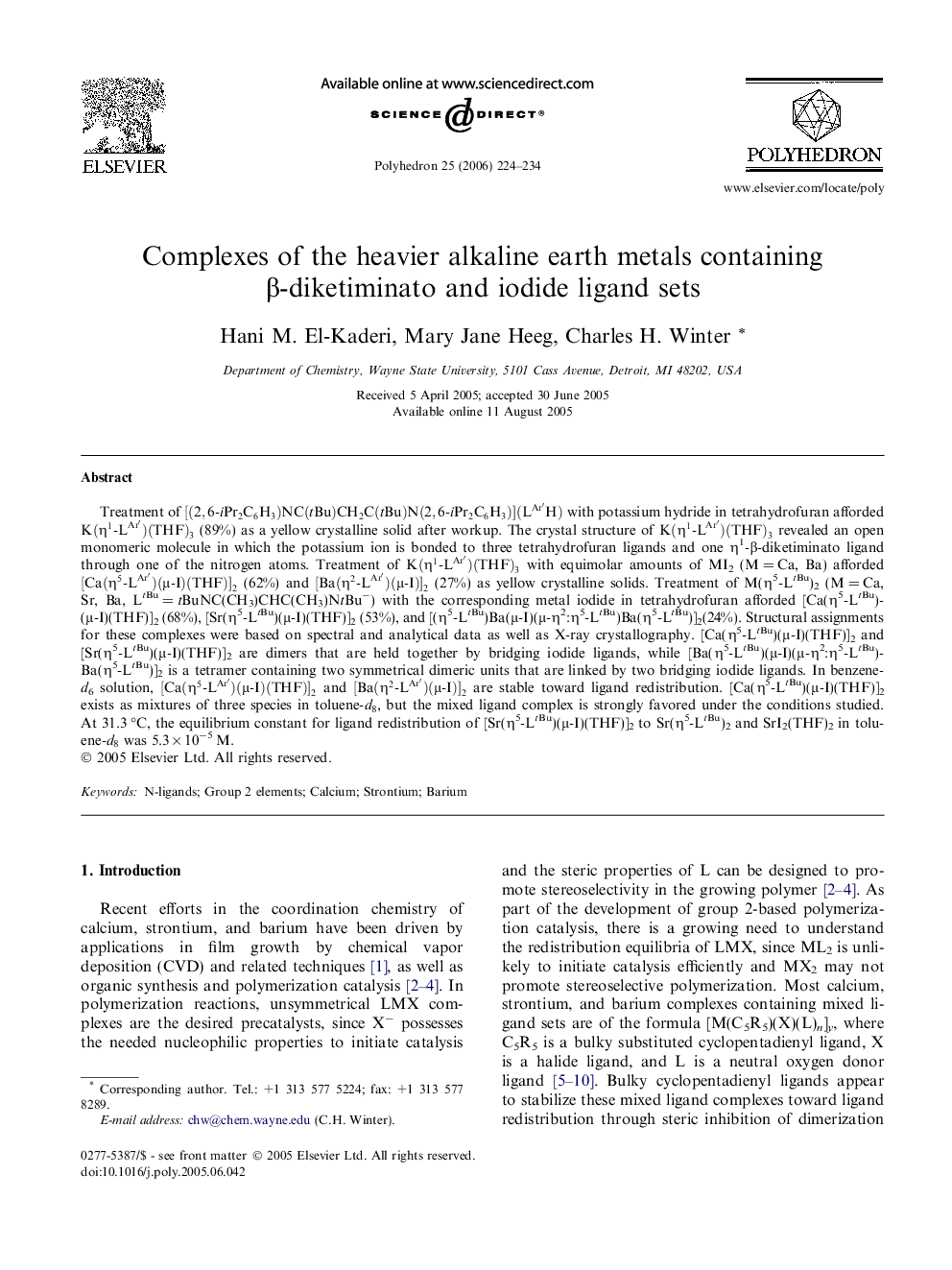| Article ID | Journal | Published Year | Pages | File Type |
|---|---|---|---|---|
| 1341000 | Polyhedron | 2006 | 11 Pages |
Treatment of [(2,6-iPr2C6H3)NC(tBu)CH2C(tBu)N(2,6-iPr2C6H3)](LAr′H)[(2,6-iPr2C6H3)NC(tBu)CH2C(tBu)N(2,6-iPr2C6H3)](LAr′H) with potassium hydride in tetrahydrofuran afforded K(η1-LAr′)(THF)3K(η1-LAr′)(THF)3 (89%) as a yellow crystalline solid after workup. The crystal structure of K(η1-LAr′)(THF)3K(η1-LAr′)(THF)3 revealed an open monomeric molecule in which the potassium ion is bonded to three tetrahydrofuran ligands and one η1-β-diketiminato ligand through one of the nitrogen atoms. Treatment of K(η1-LAr′)(THF)3K(η1-LAr′)(THF)3 with equimolar amounts of MI2 (M = Ca, Ba) afforded [Ca(η5-LAr′)(μ-I)(THF)]2[Ca(η5-LAr′)(μ-I)(THF)]2 (62%) and [Ba(η2-LAr′)(μ-I)]2[Ba(η2-LAr′)(μ-I)]2 (27%) as yellow crystalline solids. Treatment of M(η5-LtBu)2 (M = Ca, Sr, Ba, LtBu = tBuNC(CH3)CHC(CH3)NtBu−) with the corresponding metal iodide in tetrahydrofuran afforded [Ca(η5-LtBu)(μ-I)(THF)]2 (68%), [Sr(η5-LtBu)(μ-I)(THF)]2 (53%), and [(η5-LtBu)Ba(μ-I)(μ-η2:η5-LtBu)Ba(η5-LtBu)]2(24%). Structural assignments for these complexes were based on spectral and analytical data as well as X-ray crystallography. [Ca(η5-LtBu)(μ-I)(THF)]2 and [Sr(η5-LtBu)(μ-I)(THF)]2 are dimers that are held together by bridging iodide ligands, while [Ba(η5-LtBu)(μ-I)(μ-η2:η5-LtBu)Ba(η5-LtBu)]2 is a tetramer containing two symmetrical dimeric units that are linked by two bridging iodide ligands. In benzene-d6 solution, [Ca(η5-LAr′)(μ-I)(THF)]2[Ca(η5-LAr′)(μ-I)(THF)]2 and [Ba(η2-LAr′)(μ-I)]2[Ba(η2-LAr′)(μ-I)]2 are stable toward ligand redistribution. [Ca(η5-LtBu)(μ-I)(THF)]2 exists as mixtures of three species in toluene-d8, but the mixed ligand complex is strongly favored under the conditions studied. At 31.3 °C, the equilibrium constant for ligand redistribution of [Sr(η5-LtBu)(μ-I)(THF)]2 to Sr(η5-LtBu)2 and SrI2(THF)2 in toluene-d8 was 5.3 × 10−5 M.
Graphical abstractA series of mixed ligand complexes of calcium, strontium, and barium containing β-diketiminato and iodide ligands has been synthesized and characterized. Dimers or tetramers were obtained, which were connected through bridging iodide ligands. Depending on the steric bulk of the nitrogen atom substituents and the metal ion, η5-, η2-, or μ-η2:η5-β-diketiminato ligand coordination modes were observed. The combined results suggest that β-diketiminato ligands are strongly coordinating for group 2 metal ions, and are effective at stabilizing mixed ligand complexes toward redistribution equilibria.Figure optionsDownload full-size imageDownload as PowerPoint slide
